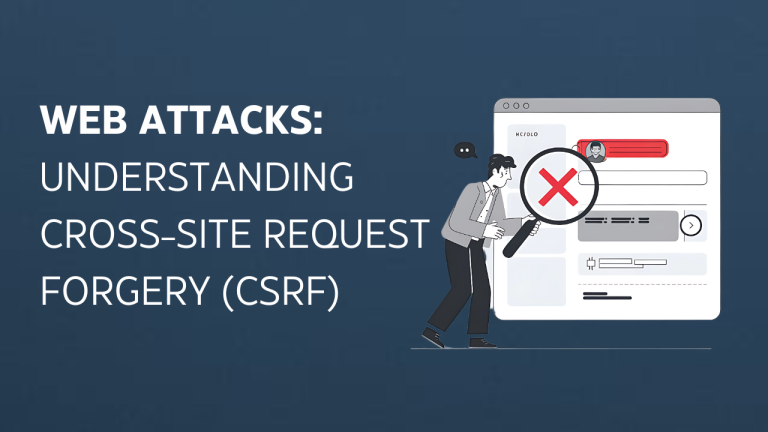Web Attacks: Understanding Cross-Site Request Forgery (CSRF)
Web Attacks: Understanding Cross-Site Request Forgery (CSRF)
- Articles
- December 17, 2024

Cross-Site Request Forgery (CSRF) is a dangerous form of web attack where an attacker tricks authenticated users into performing unintended actions on a trusted web application. It can affect platforms such as online banking systems, social media, and email services without the user’s knowledge.
In this article, we will discuss how CSRF works, provide a step-by-step explanation, and outline ways to stay protected.
What is Cross-Site Request Forgery (CSRF)?
Cross-Site Request Forgery (CSRF) is a malicious technique that forces users to execute unwanted actions on a web application where they are already authenticated. By exploiting the user’s trust, the attacker can transfer money, change passwords, or perform actions on the user’s behalf without their explicit consent.
How Does CSRF Work?
For a CSRF attack to succeed, the user must be authenticated on the targeted website or application. Here is how the attack unfolds step by step:
1. The Attacker Crafts a Malicious HTTP Request
- The attacker creates a malicious HTTP request that performs the unwanted action.
- This request is usually embedded in links, images, or forms on websites.
- Example: The request might send money to the attacker’s bank account.
2. Phishing: Trick the User into Clicking the Malicious Link
To execute the attack, the attacker tricks the victim into clicking the malicious link or visiting a compromised webpage.
- This is often achieved through phishing emails, fake offers, or deceptive content.
- Example: “Claim your free $50 now!” with a hidden malicious link.
3. The User Clicks the Malicious Link
- When the user clicks the link, the malicious HTTP request is triggered.
- Since the user is already authenticated, the system processes the action as if it was initiated by the user.
4. Victim is Redirected to Malicious or Legitimate Sites
- The victim may be redirected to a malicious website or even a legitimate site to avoid suspicion.
5. HTTP Request Sent to the Server Without Validation
- At this point, the web server receives the malicious HTTP request.
- The server processes the action without the victim’s knowledge because the user session is active.
6. Attack Succeeds: Unauthorized Action Performed
- The server executes the action—like transferring funds to the attacker’s account.
- Since the user is authenticated, the attack appears legitimate.
Why Are CSRF Attacks Dangerous?
CSRF attacks exploit the trust users have in legitimate websites. The consequences can include:
- Unauthorized Transactions: Transfer of funds without user approval.
- Data Manipulation: Modification or deletion of critical data.
- Account Hijacking: Changing passwords or access permissions.
How to Protect Against CSRF Attacks
To mitigate the risk of CSRF attacks, consider the following security practices:
1. Use CSRF Tokens
- Implement anti-CSRF tokens for every form or state-changing request.
- CSRF tokens ensure that requests originate from legitimate users.
2. SameSite Cookie Attribute
- Configure cookies with the SameSite attribute to prevent cross-origin requests.
3. Validate Referrer Headers
- Validate the origin of HTTP requests to ensure they come from trusted sources.
4. Implement Multi-Factor Authentication (MFA)
- Require users to verify their identity before performing critical actions.
5. Educate Users About Phishing
- Warn users not to click on suspicious links or visit untrusted websites.
Conclusion
Cross-Site Request Forgery (CSRF) is a critical web attack that leverages user trust to perform unauthorized actions. By understanding how CSRF works and adopting preventive measures like CSRF tokens and SameSite cookies, businesses and individuals can protect themselves from this threat.
Stay vigilant and safeguard your applications to ensure user security.